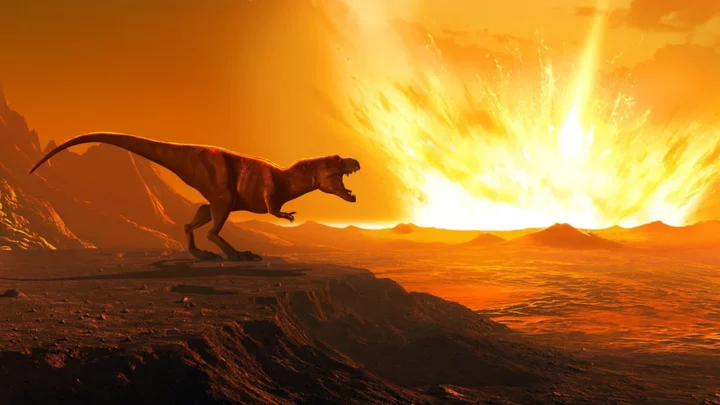
Chinese rocket that hurtled into the Moon was carrying a ‘secret object’
A mysterious object crashed into the Moon last year, and scientists think they’ve finally figured out what it was. On March 4, 2022, a piece of space junk hurtled towards the surface of our celestial companion, leaving behind not one but two craters – prompting speculation as to what exactly the manmade object was. And now, in a paper published in the Planetary Science Journal, a team of researchers at the University of Arizona (UArizona) have offered “definitive proof” that it was a booster from a Chinese space rocket that had spent several years hurtling through space. But the most interesting part of all this? The defunct piece of spacecraft was apparently carrying a secret cargo. Initially, based on its path through the sky, the UArizona team thought it was an errant SpaceX Falcon 9 rocket booster from a 2015 launch. However, after analysing how precise light signals bounced off its surface, they later concluded that it was more likely to be a booster from a Chang'e 5-T1 – a rocket launched back in 2014 as part of China’s lunar exploration programme. And yet, the Chinese space agency denied ownership, insisting that their rocket booster burned up in the Earth's atmosphere upon re-entry. But the US Space Command refuted this claim by revealing that the rocket’s third stage never re-entered the planet’s atmosphere. Furthermore, two key pieces of evidence gathered by the UArizona researchers suggested that there was more to the object than just a simple abandoned rocket booster. Firstly, the way it reflected light. The paper’s lead author, Tanner Campbell, explained in a statement: "Something that's been in space as long as this is subjected to forces from the Earth's and the moon's gravity and the light from the sun, so you would expect it to wobble a little bit, particularly when you consider that the rocket body is a big empty shell with a heavy engine on one side. “But this was just tumbling end-over-end, in a very stable way." In other words, the rocket booster must have had some kind of counterweight to its two engines, each of which would have weighed around 545kg (1,200lbs) without fuel. The stability with which the object rotated led Campbell and his colleagues to deduce that “there must have been something more mounted to [its] front”. Secondly, the team were struck by the impact the booster left when it slammed into the Moon. It created two craters, around 100ft (30.5 metres) apart, instead of one, which, according to Campbell was very unusual. He pointed out that the craters left behind by Apollo rockets are either round, if the object came straight down, or oblong if it crashed down at a shallow angle. "This is the first time we see a double crater," he said. "We know that in the case of Chang'e 5 T1, its impact was almost straight down, and to get those two craters of about the same size, you need two roughly equal masses that are apart from each other." And yet, despite the rigour of their investigation, the UArizona team have been unable to identify what exactly this additional object was. "We have no idea what it might have been – perhaps some extra support structure, or additional instrumentation, or something else," Campbell admitted. "We probably won't ever know." Sign up for our free Indy100 weekly newsletter Have your say in our news democracy. Click the upvote icon at the top of the page to help raise this article through the indy100 rankings
2023-11-21 20:22

Trail of ghostly crabs leads scientists to extraordinary underwater discovery
We’ve heard of following the yellow brick road, and even following the white rabbit, but scientists have just made a landmark discovery by following a trail of ghostly crabs. For some 20 years, experts believed there was a hydrothermal vent field off the western Galápagos Islands, but they hadn’t been able to pinpoint its exact location. However, while exploring the area they spotted a galatheid crab (also called a squat lobster), and then another, and then another. They traced the crustaceans excitedly as their number grew until, finally, they were led to the elusive hydrothermal goldmine. There are only around 550 known hydrothermal vents in the world, only half of which have actually been seen. The rest have been identified via chemical and temperature signatures in the surrounding water, as Live Science notes. Hydrothermal vents are formed when water seeps into the rock of the seafloor at either a plate margin or where magma is rising to the surface in another part of the plate. The magma heats the water, which causes it to rise, before it’s expelled through fissures in the rock, often forming what are known as chimneys. The new Galápagos field, discovered thanks to the crabs which aggregate around deep-sear vents, extends more than 98,800 square feet (9,178 square metres), and consists of five geyser-like chimneys and three hot springs. The highest temperature so far recorded there is a staggering 288C (550F). As well as the the geysers, hot springs and crabs, the team, from the Schmidt Ocean Institute, found a thriving ecosystem of incredibly adapted organisms. "There were giant tube worms, which can be a couple (of) metres long. There were very large clams, sometimes called dinner plate clams, as well as mussels," said Roxanne Beinart, a biological oceanographer who co-led the expedition. To locate the hydrothermal field, the researchers first began searching the general region where a chemical anomaly had been identified in 2008. "One of the anomalies that we look for is a lens of low oxygen water," expedition co-leader Jill McDermott, a chemical oceanographer at Lehigh University in Pennsylvania, told Live Science. "Oxygen is completely removed through circulation in the seafloor. So the water that's expressed at the seafloor is devoid of oxygen." The team then followed this plume of oxygen-poor water until it disappeared — implying they were close to the vent. They then launched a remotely operated vehicle to inspect the seafloor and traced the breadcrumb trail of crabs to the vent field itself. “With 75 per cent of the seafloor still to map, finding this new vent field shows how much we still have to learn about our planet and those who live on it,” the Schmidt Ocean Institute’s Executive Director Dr Jyotika Virmani said in a statement. “I am continually amazed by the otherworldly beauty of our seafloor and look forward to uncovering more.” And what did the team christen the new hydrothermal vent field? Why, the “Sendero del Cangrejo,” or “Trail of the Crabs,” of course. Sign up for our free Indy100 weekly newsletter Have your say in our news democracy. Click the upvote icon at the top of the page to help raise this article through the indy100 rankings
2023-11-21 18:46

Bond Traders Boost US Recession Bets as the Economy Stumbles
Treasury investors are turning increasingly skeptical the Federal Reserve will deliver a soft landing for the US economy
2023-11-21 17:50

Doctor shares 6 signs that you might be a borderline alcoholic
Are you questioning your relationship with alcohol? Or perhaps you're concerned about someone in your life? Dr. Dave Nichols - an NHS GP - shared six signs that you may be a "borderline alcoholic" to help you know if it's time to stop. Dr. Nichols spoke to The Sun about what makes someone "dangerously close to the line" of drinking too much. "A lot of people know that they sometimes drink too much, but many don't know where the line is when it comes to problematic alcohol consumption," Dr. Nichols explained. "It describes a pattern of harmful drinking where you may have a drink, or several drinks, every day or regularly binge drink." To help people gain a better understanding of their drinking habits, he shared six signs to look out for: drinking alcohol every day without realising it; binge drinking often; only socialising if alcohol is involved; drinking frequently during the day; finding it irritating when others are not drinking; and consuming more than the recommended government guidelines. The NHS recommends drinking no more than 14 units spread across three days or more. Which equates to roughly six medium (175ml) glasses of wine, or six pints of 4 per cent beer. Dr Nichols warns that borderline alcoholics are at risk of falling into dependence: "While you may not yet have developed a physical dependence to this pattern of drinking, you are at high risk of developing alcohol dependence. "Borderline alcoholics might experience symptoms such as abdominal pain, stress, anxiety, bad skin, trouble sleeping, irritability and higher blood pressure." If you're looking to cut back on your alcohol consumption, events such as Dry January are a great way to kickstart habits. Dr Nichols also suggested socialising in sober settings, such as exercise classes, dog walks, or coffee shops. If you are worried about your alcohol consumption find a list of NHS resources here. Sign up to our free Indy100 weekly newsletter Have your say in our news democracy. Click the upvote icon at the top of the page to help raise this article through the indy100 rankings. How to join the indy100's free WhatsApp channel
2023-11-21 00:15

Scientists say you don't need to be religious to have a 'moral compass'
Scientists have decided it’s official – people do not necessarily have to believe in a “god” to have a moral compass. A group of four University of Illinois surveys found that while there were subtle differences in behaviour between groups of atheists and religious people – or “theists” – they live by the same moral codes. Tomas Ståhl of the University of Illinois said: “The most general take-home message from these studies is that people who do not believe in God do have a moral compass. "In fact, they share many of the same moral concerns that religious believers have, such as concerns about fairness, and about protecting vulnerable individuals from harm.” The first two surveys crowdsourced responses from hundreds of American residents, and found that religion was unrelated to amoral tendencies, whether people would endorse liberty or oppression or whether people cared about being fair to others. The second two surveys compared thousands of people across the US and Sweden, which is a much more secular country. The data came up with the same results. Mainstream religions are on a downward trend worldwide. In the UK, for example, just 46 percent of people identified as Christian in the 2021 census, compared to 59 percent in 2011. The US has seen similar declines. Ståhl added: “However, disbelievers are less inclined than believers to endorse moral values that serve group cohesion, such as having respect for authorities, ingroup loyalty, and sanctity… “It is possible that the negative stereotype of atheists as immoral may stem in part from the fact that they are less inclined than religious people to view respect for authority, ingroup loyalty, and sanctity as relevant for morality, and they are more likely to make moral judgments about harm on a consequentialist, case by case basis.” It’s news that will come as little surprise to the estimated 750 million atheists across the globe, of course. But for people who still think religion is the key to morality, it could be food for thought. How to join the indy100's free WhatsApp channel Sign up to our free indy100 weekly newsletter Have your say in our news democracy. Click the upvote icon at the top of the page to help raise this article through the indy100 rankings.
2023-11-20 23:29

Scientists discover fluffy 'alien' planet where it rains sand
Experts have discovered a fluffy “alien” planet where it rains sand in stunning new observations from the James Webb Space Telescope. The bizarre-looking planet is officially known as exoplanet WASP-107b and has a cloud of silicate sand that exists high within its atmosphere giving it its strange fluffy appearance. NASA’s James Webb Space Telescope (JWST) has been responsible for some astounding findings since it was launched in 2021, including a mysterious galaxy shaped like a question mark. Now, observations made by the telescope have been used by experts who have been able to determine the atmospheric composition of the exoplanet that was pictured. A team of European astronomers found that water vapour, sulfur dioxide and silicate sand clouds existed in the exoplanet’s diverse atmosphere. The exoplanet WASP-107b is one of the lowest-density planets that astronomers are aware of. To put it into context, it is the same size as Jupiter, but has just 12 per cent of Jupiter’s mass. Thanks to its low density, it has allowed scientists to take a deeper look into the planet’s atmosphere, exploring 50 times deeper than would be possible with denser planets. The discovery of sulfur dioxide was a surprise because the host star it orbits only emits a small amount of high-energy light photons. But, its low-density atmosphere allows the photons to penetrate WASP-107b’s atmosphere where the chemical reaction that creates sulfur dioxide can occur. They also discovered that it essentially rains sand on the exoplanet due to the presence of clouds high in the atmosphere made up of fine silicate particles. Experts believe the clouds of sand form in the same way as rain does on Earth as the droplets continually fall and condense back into cloud form. The lead author of the study, Leen Decin from Katholieke Universiteit Leuven in Belgium, explained: “JWST is revolutionizing exoplanet characterisation, providing unprecedented insights at remarkable speed.” She added: “The discovery of clouds of sand, water, and sulfur dioxide on this fluffy exoplanet… is a pivotal milestone. It reshapes our understanding of planetary formation and evolution, shedding new light on our own solar system.” How to join the indy100's free WhatsApp channel Sign up to our free indy100 weekly newsletter Have your say in our news democracy. Click the upvote icon at the top of the page to help raise this article through the indy100 rankings.
2023-11-20 18:29

'Lost City' deep in the Atlantic is like nothing else we've ever seen on Earth
The reality of what lies within our oceans has fascinated people since time immemorial, so it’s no wonder we’ve created countless myths about the watery depths. But step aside, Atlantis, scientists have discovered a real Lost City beneath the waves, and this one is teaming with life. The rocky, towering landscape is located west of the Mid-Atlantic Ridge mountain range, hundreds of metres below the surface of the Atlantic Ocean, and consists of massive walls, columns and monoliths stretching more than 60 metres (200ft) tall. To be clear, it’s not the home of some long-forgotten human civilisation, but that doesn’t make its existence any less significant. The hydrothermal field, dubbed the “Lost City” upon its discovery in the year 2000, is the longest-lived venting environment known in the ocean, Science Alert reports. Nothing else like it has ever been found on Earth, and experts think it could offer an insight into ecosystems that could exist elsewhere in the universe. For more than 120,000 years, snails, crustaceans and microbial communities have fed off the field’s vents, which spout out hydrogen, methane and other dissolved gases into the surrounding water. Despite the absence of oxygen down there, larger animals also survive in this extreme environment, including crabs, shrimps and eels. Although, they are, admittedly, rare. The hydrocarbons produced by its vents were not created by sunlight or carbon dioxide, but by chemical reactions way down on the seafloor. This is how life on our planet may have originated some 3.7 billion years, and how it could be formed on others. "This is an example of a type of ecosystem that could be active on Enceladus or Europa right this second," microbiologist William Brazelton told The Smithsonian back in 2018, referring to the moons of Saturn and Jupiter respectively. "And maybe Mars in the past." The tallest of the Lost City’s monoliths has been named Poseidon, after the Greek god of the sea, and it measures more than 60 metres high. Meanwhile, just northeast of the tower, is a cliffside where the vents “weep” with fluid, producing "clusters of delicate, multi-pronged carbonate growths that extend outward like the fingers of upturned hands", according to researchers at the University of Washington. There are now calls for the Lost City to be listed as a World Heritage site to protect the natural phenomenon, particularly given humans’ propensity to destroy precious ecosystems. Back in 2018, it was confirmed that Poland had won the rights to mine the deep sea around the thermal field. And whilst, in theory, the Lost City would not be touched by such works, as Science Alert notes, the destruction of its surroundings could have unintended consequences. Sign up for our free Indy100 weekly newsletter Have your say in our news democracy. Click the upvote icon at the top of the page to help raise this article through the indy100 rankings
2023-11-20 17:57

Dinosaurs still exist on other planets, say scientists
The dinosaurs may have been extinct for more than 65 million years but scientists have suggested that they could still exist as aliens on other planets. Researched published in the Monthly Notices of the Royal Astronomical Society suggests that dinosaurs might not only be on other planets but that we could also find them. The study suggests that if scientists researched compounds that are not currently on Earth but ones that were around during the age of the dinosaurs then it may yield some results. One key element that scientists believe could unlock what would be a groundbreaking discovery is oxygen. The levels of oxygen on Earth at the moment are around 21 per cent but during the time of dinosaurs it was higher at 30 per cent. This, in theory, allowed the dinosaurs to flourish and rule the planet for millions of years. The study suggests that if similar levels of oxygen can be discovered on faraway planets then the conditions could be right for alien like dinosaurs to exist. The study's co-author Lisa Kaltenegger said in a statement: "Modern Earth's light fingerprint has been our template for identifying potentially habitable planets, but there was a time when this fingerprint was even more pronounced — better at showing signs of life." She adds: "This gives us hope that it might be just a little bit easier to find signs of life — even large, complex life — elsewhere in the cosmos." One clue that could unlock this discovery which scientists are looking for are signs of a Phanerozoic stage on a planet which would allow creatures like dinosaurs to evolve. The study's lead author, Rebecca Payne of Cornell University, said: "The Phanerozoic is just the most recent 12 per cent or so of Earth's history, but it encompasses nearly all of the time in which life was more complex than microbes and sponges. These light fingerprints are what you'd search for elsewhere if you were looking for something more advanced than a single-celled organism." If they are successful in finding these conditions on other planets then Kaltenegger believes it could lead to the discovery of dinosaurs that have never been found on Earth. "Hopefully we'll find some planets that happen to have more oxygen than Earth right now because that will make the search for life just a little bit easier," she said. "And, who knows, maybe there are other dinosaurs waiting to be found." Sign up for our free Indy100 weekly newsletter Have your say in our news democracy. Click the upvote icon at the top of the page to help raise this article through the indy100 rankings.
2023-11-20 00:28

10 Fascinating Facts About ‘Ex Machina‘
Alex Garland‘s directorial debut contains what might be the most dense, obscure in-joke in cinema history.
2023-11-19 21:23

Profit Recession Ends as a Challenging Holiday Season Begins
As earnings season draws to a close, so does the S&P 500 Index’s profit recession. But that doesn’t
2023-11-18 22:56

Elon Musk mocked as Starship experiences 'rapid unscheduled disassembly'
Elon Musk's SpaceX company have once again attempted to launch the world's biggest rocket, Starship, but lost contact within eight minutes of takeoff. The launch from site near Boca Chica in Texas, east of Brownsville, did see the rocket reach space for the first time but despite its super heavy booster still experienced what is called "a rapid unscheduled disassembly" - or to put it bluntly - it blew up. SpaceX's livestream host John Insprucker said during the broadcast: "We have lost the data from the second stage... we think we may have lost the second stage." Despite losing the rocket and the obvious explosion the launch has still been hailed as a success by SpaceX and far more progress was made then the first test that they carried out in April, when another 'rapid unschedueled disassmbly' occured. Although it went well from SpaceX and Elon Musk's perspective people couldn't help but be amused by the use of the 'rapid unschedueld disassembly' terminology, with many mocking Musk himself. Meanwhile, Musk is facing his own problems on X/Twitter after it was discovered that the platform had helped promote pro-Nazi and anti-semitic material alongside big name advertisers on the site. This prompted IBM, one of the biggest brands on X/Twitter, to pull all the adverts from the site. In response Musk has threatened to drop a 'thermonuclear lawsuit' on US media watchdog, Media Matters, who had released the damaging data. Sign up to our new free Indy100 weekly newsletter Have your say in our news democracy. Click the upvote icon at the top of the page to help raise this article through the indy100 rankings.
2023-11-18 22:51

A newly found ancient language in Turkey is yielding new discoveries
Archaeologists in Turkey are slowly unravelling the secrets of a previously unknown ancient language. And among them are revelations that long-forgotten civilisations used language to promote multiculturalism and political stability. The ancient clay tablets unearthed from archaeologists, in the ancient capital of the Hittite Empire at Hattusa, were recently found to contain the previously unknown language. Researchers had dusted off nearly 30,000 unique tablets at the scene – a UNESCO World Heritage Site – with most written in Hittite, and a few in the brand new language. The ongoing excavations have since revealed that the imperial civil service had whole departments whose job it was to research their subject peoples’ religions. Back in the second millennium BC, Hittite leaders told their officials to record religious ceremonies and other traditions of subject peoples by writing them in their respective local languages. The idea was that the traditions would be preserved and incorporated into the wider empire, in what appears to be a push towards multiculturalism. The fact that multiculturalism was such a prominent part of Bronze Age culture certainly has resonances in the modern day, where debates around immigration and multiculturalism continue to be a hot topic. So far, experts have found at least five subject ethnic groups who have had the treatment, with the latest example unearthed two months ago. It was written in a previously unknown Middle Eastern language that had been lost for up to 3,000 years. The language is being called Kalasmaic, because it would have been spoken by a subject people in an area called Kalasma in the northwest of the empire. And while only five minority languages have so far been found on the Bronze Age tablets, the reality is that there were probably at least 30, archaeologists say. Daniel Schwemer, a Wurzburg University professor who is leading the investigation into the newly discovered texts, said: “Bronze Age Middle Eastern history is only partly understood – and discovering additional clay tablet documents is helping scholars to substantially increase our knowledge.” How to join the indy100's free WhatsApp channel Sign up to our free indy100 weekly newsletter Have your say in our news democracy. Click the upvote icon at the top of the page to help raise this article through the indy100 rankings.
2023-11-18 00:17
